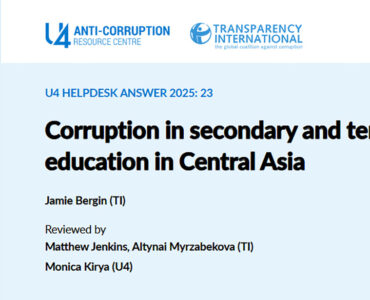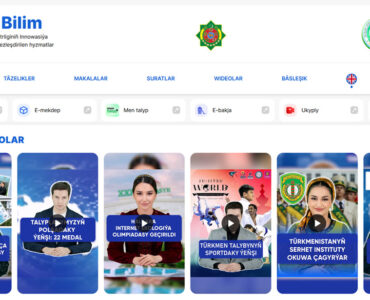Summary: In Turkmenistan, older people are celebrated in official rhetoric but often live in poverty with little support. They receive the lowest pension in Central Asia, and men live just 2.7 years after retirement – the shortest in the region. Despite growing needs, one in four receives no pension, and access to essential public services remains limited due to discriminatory policies.
The older adults make up 8% of Turkmenistan’s population. Yet, the country’s treatment of its elders reflects systemic neglect rather than respect. Turkmenistan’s older population has the shortest life expectancy in Central Asia and faces widespread poverty, discrimination, and barriers to welfare access. While the retirement age is 62 for men and 57 for women, many older persons, especially men have too short life expectancy to even enjoy their retirements.
While the state proclaims, “Honouring elders and increasing their authority are among the noble traditions bequeathed by our ancestors,” the reality reveals systematic abandonment. As stated by the UN 2024 Common Country Analysis (CCA) for Turkmenistan, “the relatively small elderly population in Turkmenistan has a traditionally privileged position in society but they still experience social and economic vulnerability, the addressing of which calls for better public policies”. These privileges are mostly based on traditional family dynamics and the state’s portrayal of the older population as repositories of wisdom whose primary role is guiding younger generations and passing on traditional values. Yet, the older persons remain widely invisible with their needs often inadequately addressed in Turkmenistan, particularly in the welfare system, leaving the older population in a precarious position, often relying on the only privilege Turkmen society offers – the family.
The UN 2024 CCA gives older adults a moderate vulnerability score of 2.4 out of 5. Yet, deeper analysis reveals that 80% of them simultaneously experience multiple risk factors – such as discrimination, geographic isolation, poor governance, and low socio-economic status – averaging a 4.2 out of 5 impact intensity. The report emphasizes that addressing these challenges demands structural reforms and inclusive social development policies to ensure equitable access to quality services.
Despite Turkmenistan’s commitment to the Sustainable Development Goals (SDGs), only three national indicators specifically mention older adults. Notably absent is SDG target 3.4, which addresses premature mortality from non-communicable diseases and mental health – issues that disproportionately affect older populations.
According to the World Bank, Turkmenistan’s average spending on social protection and pensions was 3.5% of GDP from 2015-2022. By 2023, this dropped to just 1.4%. The World Bank underlines that “despite abundant revenues from commodity exports, social sectors appear underfinanced […] compared to Turkmenistan’s income peers”. Only 10.9% of vulnerable individuals receive any form of cash-based assistance.
These gaps are evident in the pension system of Turkmenistan. According to the 2022 Census, only 420,000 receive retirement pensions, leaving 1 in 4 older persons without retirement benefits. Of those excluded, about half receive other forms of government support (e.g., government allowance, disability allowance, and other sources (data provides no clarification)), while the other half –12% of the older population – receive no government assistance.
Efforts to reform the welfare system have been hindered by a lack of official, reliable microdata. As the World Bank stresses, without such data, it’s nearly impossible to design effective and targeted safety nets.
The World Bank has been raising the issue of ineffectiveness of the welfare system in Turkmenistan for years, including within its 2017-2029 project supporting the Government of Turkmenistan in strengthening its national welfare monitoring system. However, issues persist, with existing gaps or complete lack of data. According to the World Bank “without microdata – especially reliable and official data, it is difficult to identify who is affected, to what degree, and how best to mitigate the burden for the vulnerable”, and warns, “until the country is able to properly measure welfare, any further distributional analysis that could inform policy or help with developing a targeted safety net will be stymied”.
Bureaucratic and Logistical Barriers
Beyond inadequate funding, older persons face bureaucratic hurdles that block access to benefits. The UN Human Rights Council and the Committee on Economic, Social and Cultural Rights have repeatedly raised concerns about the propiska (residency registration) system, which restricts access to social benefits for those not living in their registered location. They recommend replacing it with a system that ensures freedom of movement and equal access to economic, social, and cultural rights.
Since 2018, to access state pension and benefits, older persons must submit documents every six months to prove they are not deceased. These require visits to family doctors and other offices, as well as a provision of a certificate from a passport office to the regional pension fund. Those unable to provide documents lose access to their pensions, those who manage, face challenges with withdrawing cash from their funds. These demands are especially burdensome for those with limited mobility, resulting in gaps in coverage and lost benefits for many.
Inadequate Pensions and Rising Poverty
For those who do receive pensions, the amount is often insufficient, particularly, for women. In 2025, the minimum pension is 550 TMT. While at an official exchange rate it is equivalent to $157.1 it is just $28.20 per month at black market rates. The average pension in 2022 was 703.1 TMT ($35), with women receiving even less: 599.3 TMT ($30). Disability pensions average just 630.8 TMT, with women again receiving lower benefits 586.7 TMT. Furthermore, social benefits are not fully adjusted for inflation and existing mechanisms for targeted social assistance are insufficient, while no national poverty baseline exists in Turkmenistan.
These amounts fall far below the international poverty line of $2.50/day. When compared to neighboring countries – Kazakhstan ($175/month), Kyrgyzstan ($108), Uzbekistan ($93), and Tajikistan ($34) – Turkmen pensions are among the lowest in real terms.
Human Rights Watch in its study underlined the ongoing food crisis in Turkmenistan with shortages in subsidized food since 2016 affecting vulnerable groups, including pensioners. Households spend 52.9% of their income on food including long hours waiting in lines for subsidized food. Single pensioners are especially affected as they are unable to wait in long lines, and effectively lose access to already limited government-subsidized food.
Donate to support Turkmen analysts, researchers and writers to produce factual, constructive and progressive content in their efforts to educate the public of Turkmenistan.
SUPPORT OUR WORKHealth Challenges and the Shortest Post-Retirement Lives in the Region
Health-related spending in Turkmenistan is also among the lowest in the region. Citizens cover 77% of healthcare costs out-of-pocket (compared to 27.7% in Kazakhstan), while government spending on healthcare was just 1.4% of GDP in 2023. The healthcare workforce has also shrunk: from 3,000 doctors in 2007 to 2,592 in 2022. The 2024 CEDAW Committee report called for greater investment in affordable elder care facilities to fill glaring infrastructure gaps.
These conditions directly affect life expectancy. Despite having 186% higher income per capita than Tajikistan, Turkmenistan has the lowest life expectancy (69.5 years): 2 years lower than average in Central Asia. Men in Turkmenistan live, on average, just 2.7 years after retirement – the shortest post-retirement life expectancy in Central Asia. For comparison: Kyrgyz men live 4.6 years post-retirement, Tajik men 5.8 years, and Uzbek men 9.6 years. Women in Turkmenistan fare better (14.7 years after retirement), but often face poverty, widowhood, and serious health issues.
In conclusion, Turkmenistan’s treatment of its elders is a stark reflection of policy failure. Shrinking social spending, bureaucratic hurdles, discriminatory registration systems, low pensions, and inadequate healthcare have created a system that fails the country’s most vulnerable. The data and testimonies paint a clear picture: without urgent reform, the state’s promises to “honour its elders” will continue to ring hollow.
Appendix 1: Social Welfare
Turkmenistan’s social welfare system is governed by three main legal texts: the Law on Social Services, the Code of Turkmenistan on Social Protection of the Population, and the Law on State Pension Insurance.
Healthcare and Social Services:
The Law on Social Services recognizes old age as a basis for social assistance (Art.16), including home-based care and 24/7 institutional care for those with reduced self-care abilities (Art.18). These services include medical, social, and rehabilitative support to maintain or improve health (Art.17). The law also guarantees proper care standards in residential institutions, protection from neglect, individualised approaches, and access to service-related information (Art.21).
The Code of Turkmenistan on Social Protection of the Population reinforces healthcare access and introduces early retirement options for those with health limitations (Art.24). It offers both home-based and institutional care services. Veterans are entitled to significant health benefits (Arts.106-123), including free medications, dental and prosthetic care, and healthcare priority. WWII labor veterans (born before 1931) receive a 50% discount on medicines.
Pensions:
The pension system includes both mandatory and voluntary contribution schemes (Art.10) and covers six types: old-age, length-of-service, professional, disability, survivor’s, and funded pensions, plus special pensions for distinguished service (Art.21). Pension amounts are based on accumulated capital and life expectancy (Arts.34-36), with no maximum ceiling and a minimum guaranteed for qualifying contribution years (Art.41). Benefits cease only in specific cases such as emigration or death (Art.43).
Standard retirement ages are 62 for men and 57 for women, with early retirement options for mothers of three or more children, people exposed to radiation, and individuals with certain disabilities (Arts.23-25). Recognised work experience includes military service, caregiving for disabled relatives, diplomatic service abroad, and childcare leave (Art.29).
The Code ensures pension continuity for elderly individuals who are hospitalized, receiving psychiatric treatment, or incarcerated, with specialized payment mechanisms for each. Nursing home residents receive at least 20% of conditional pensions, hospitalized patients get full payments delivered to treatment facilities, psychiatric patients retain pension rights with varied disbursement schedules based on treatment duration, and incarcerated pensioners maintain payment access through institutional or personal accounts (Arts.44-47).
Other Social Support:
Section IV of the Code on Social Protection outlines services for individuals with limited self-care abilities, including legal and domestic support, funded mainly through national and local budgets. It also defines six categories of veterans with specific privileges. Beyond health benefits, Great Patriotic War veterans and combat-disabled individuals are entitled to housing repairs, utility and transport benefits, while WWII labor veterans receive free public transport, priority telephone installation, and extended benefits for surviving dependents (Arts.106-123).
The Law on State Pension Insurance complements the Code by detailing pension administration, insurance coverage, and contribution calculations.






